Battle for Email: The Email Deliverability Card Game
Learning deliverability shouldn’t be boring.
Play the game for marketers, developers, and email geeks who’ve ever shouted, “Why did this go to spam?!”.

Why we created Battle for Email?
Email deliverability is full of mystery, acronyms, and hard-to-grasp concepts.
We wanted a way to teach them without a single PowerPoint slide.
So we turned it into a game.
Play your way to the inbox
No printer, no problem. The digital version of our Deliverability Deck is ready to play: straight from your browser.
Tackle real deliverability challenges, earn points for smart decisions, and see how your score stacks up against your teammates.
Perfect for a quick coffee break or team warm-up: all you need is a screen and a bit of competitive spirit.
Why teams play Battle of Email?
🕹️ How to play?
Setup:
Choose the first Dealer (the oldest player). Shuffle the deck and deal 5 cards to each player.
The Dealer reveals a Mail card: that’s your mission this round.
Gameplay:
Players secretly play up to one Helper (for themselves) and one Blocker (against someone else).
Flip them over, calculate: Base Deliverability + Helpers − Blockers.
Highest total wins the Mail card and its points.
Continue:
Draw back up to 5 cards and keep playing until all Mail cards are used.
The player with the most points wins! If there’s a tie, the tied players keep playing until one gains the lead – or they run out of cards.


Bring email deliverability to the table, literally
Each card is inspired by real challenges senders face every day: from broken links to raving fans.
Master them all, and become the ultimate inbox champion.
Print and play → get a free PDF deck for your team
Game Cards
Password Reset

This card represents the most trustworthy type of email: the one users ask for. Since it’s transactional and expected, providers prioritize it almost instantly. In real life, password resets rarely land in spam unless something technical breaks: a misconfigured authentication record, a broken link, or a suspicious sending domain.
In the game, it’s a reminder that even the most reliable messages can fail if your setup isn’t clean.
Welcome Email
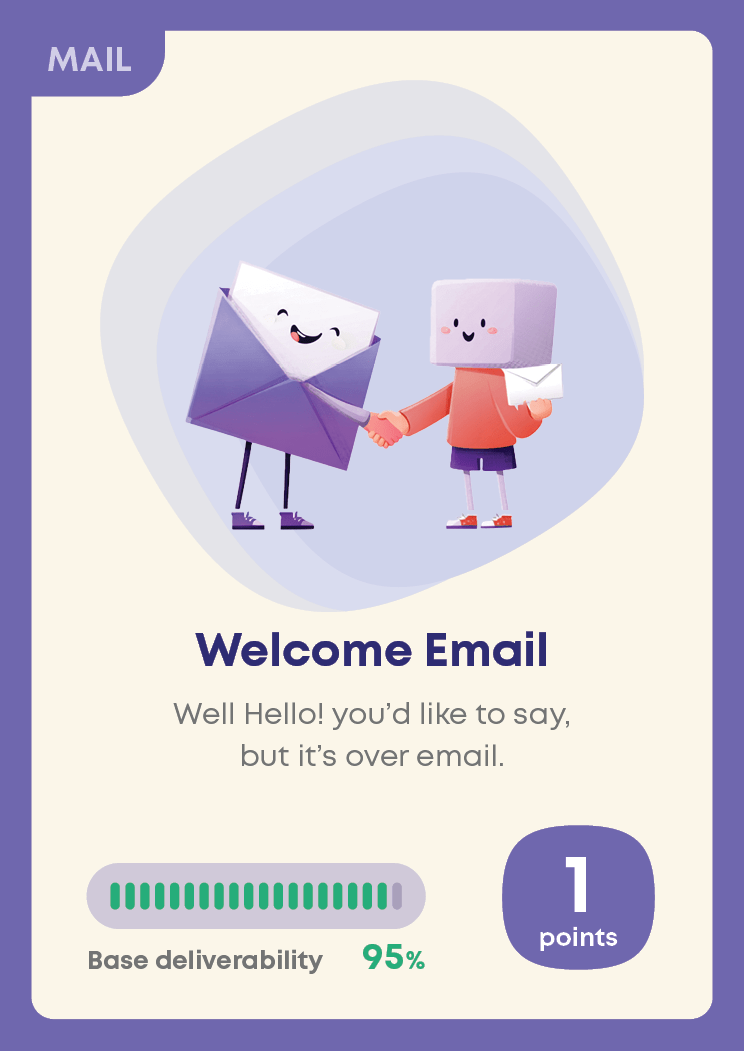
Your digital handshake. It’s light, friendly, and highly deliverable because recipients expect it.
But even this easy card has a trap: overdesign.
Add too many GIFs, CTAs, or links, and your warm greeting ends up in the Promotions tab.
In play, it teaches that simplicity and authenticity always win early trust.
Invoice Reminder
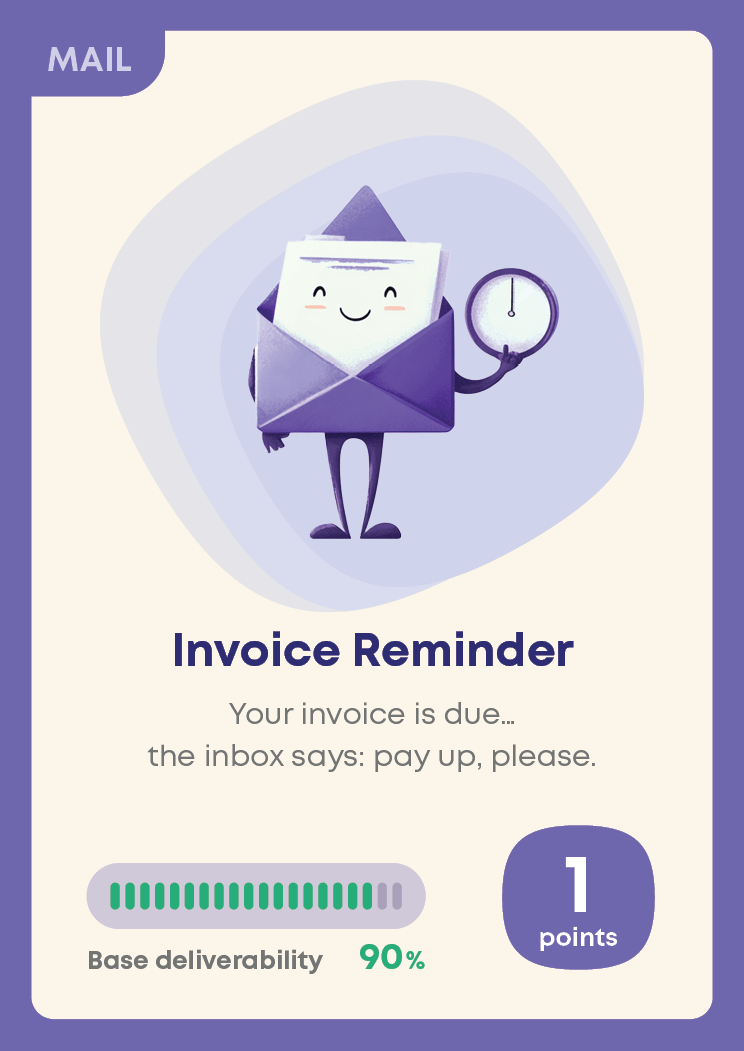
Simple and factual, invoice reminders are safe… unless you overdo it.
Sending too many too often makes both filters and recipients suspicious.
In real email life, balance and timing are everything.
In the game, it’s a lesson in respecting frequency and intent.
Customer Support Reply
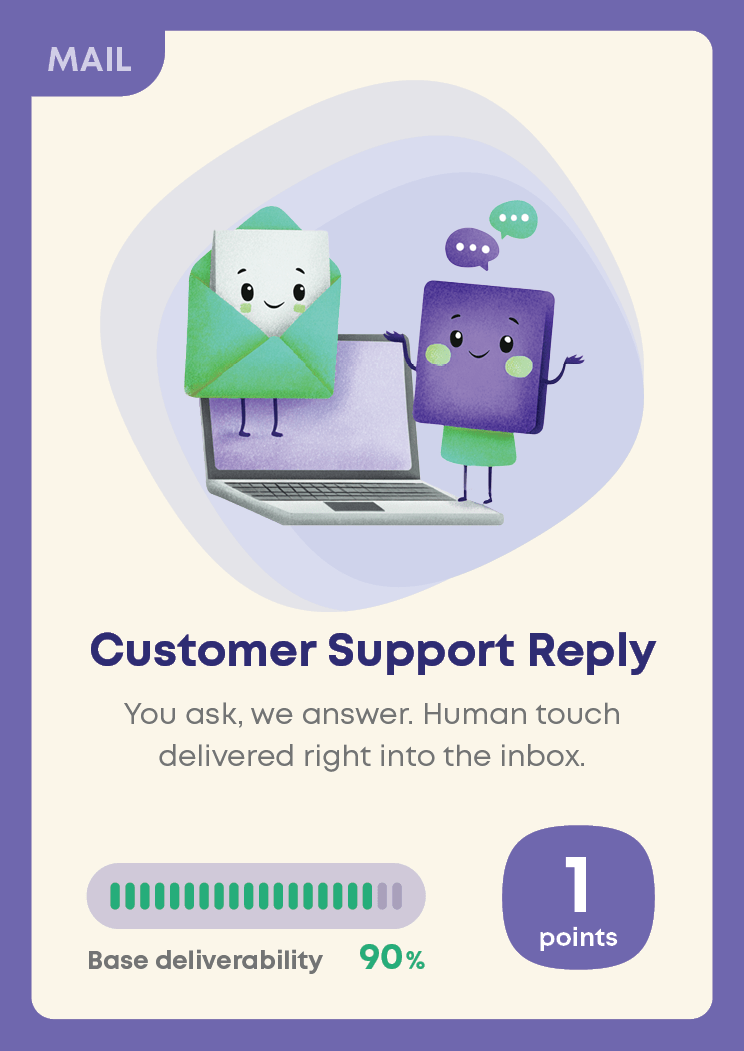
Plain text, conversational, and human… that’s what inboxes love.
Replies from support addresses usually reach the inbox because they look natural and personalized.
The only risk? Adding attachments or images that make them feel automated.
This card rewards genuine tone and minimal formatting.
Order Confirmation
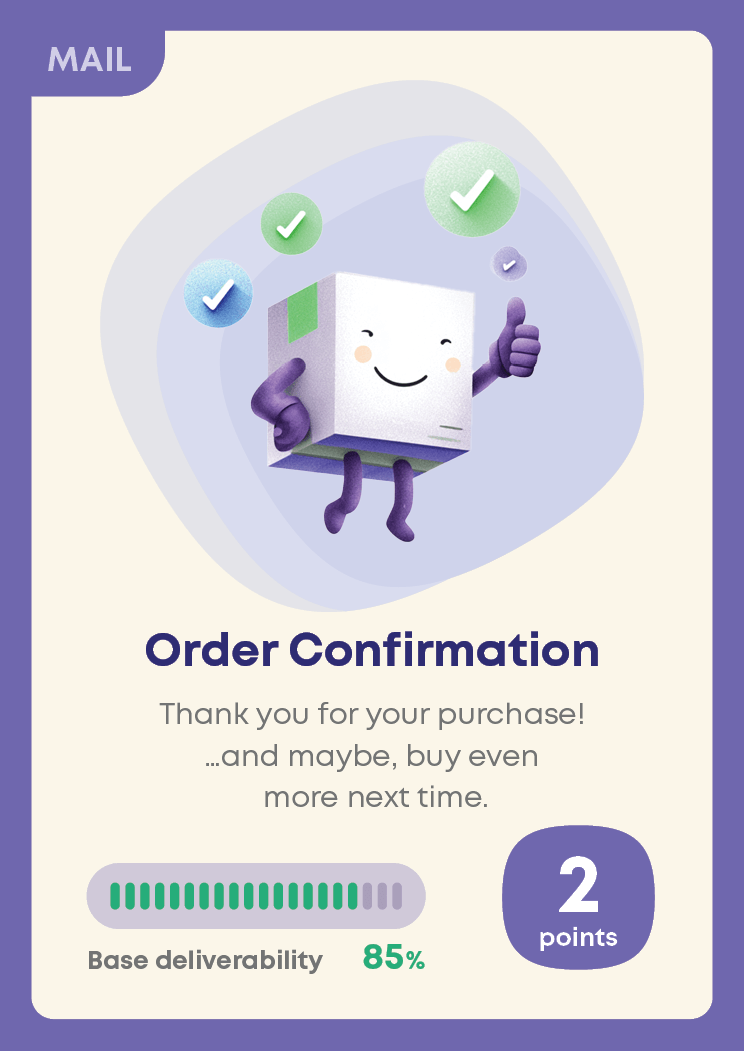
Everyone expects a receipt.
Order confirmations are the heart of e-commerce deliverability: but heavier HTML layouts and upsell banners can make them feel commercial.
In the game, it highlights how even legitimate emails can slip into Promotions when marketers get too eager.
Shipping Notification
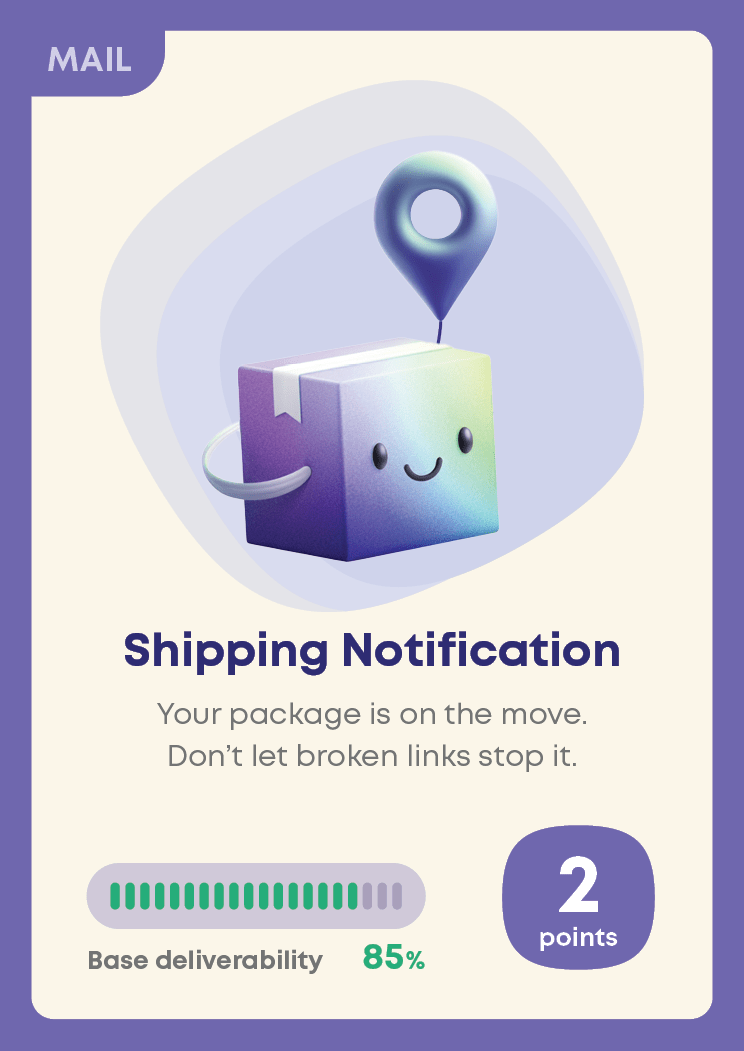
A tracking link in your inbox feels useful — unless it’s broken.
This card shows how transactional messages walk a fine line between helpful and suspicious.
A single broken URL or misleading copy can ruin an otherwise perfect sender reputation.
Customer Survey Invite
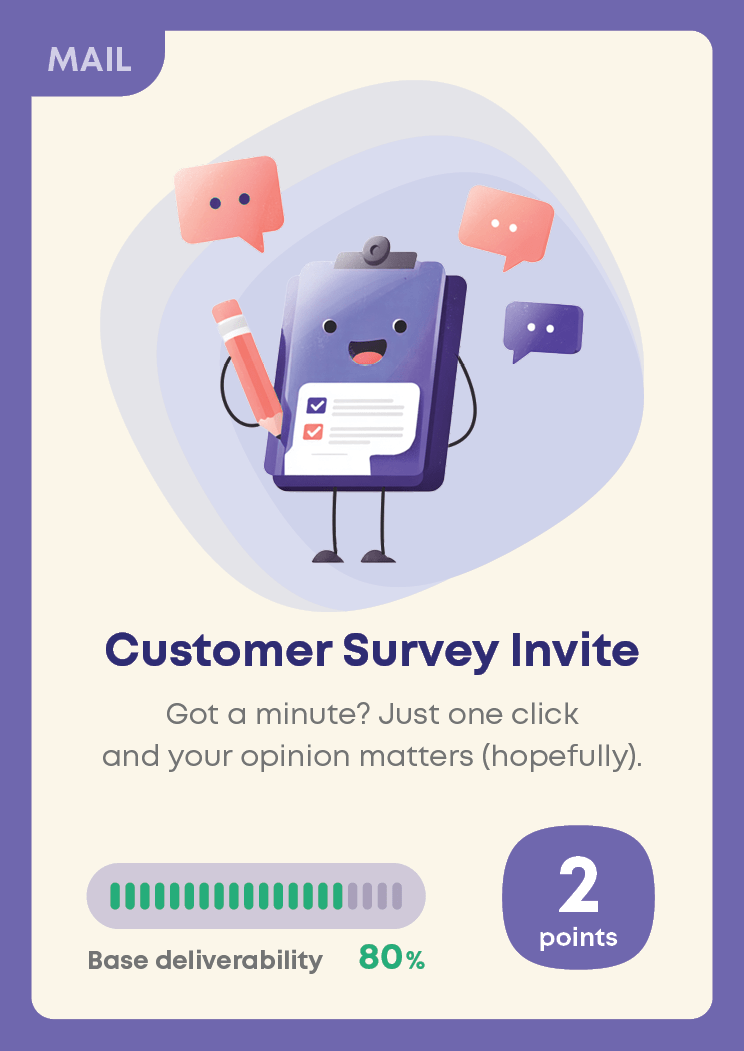
This card is all about engagement.
Surveys only deliver well if recipients actually interact.
When users ignore them, filters downgrade future campaigns.
It’s a reminder that engagement – not just sending – defines your long-term deliverability health.
Weekly Newsletter
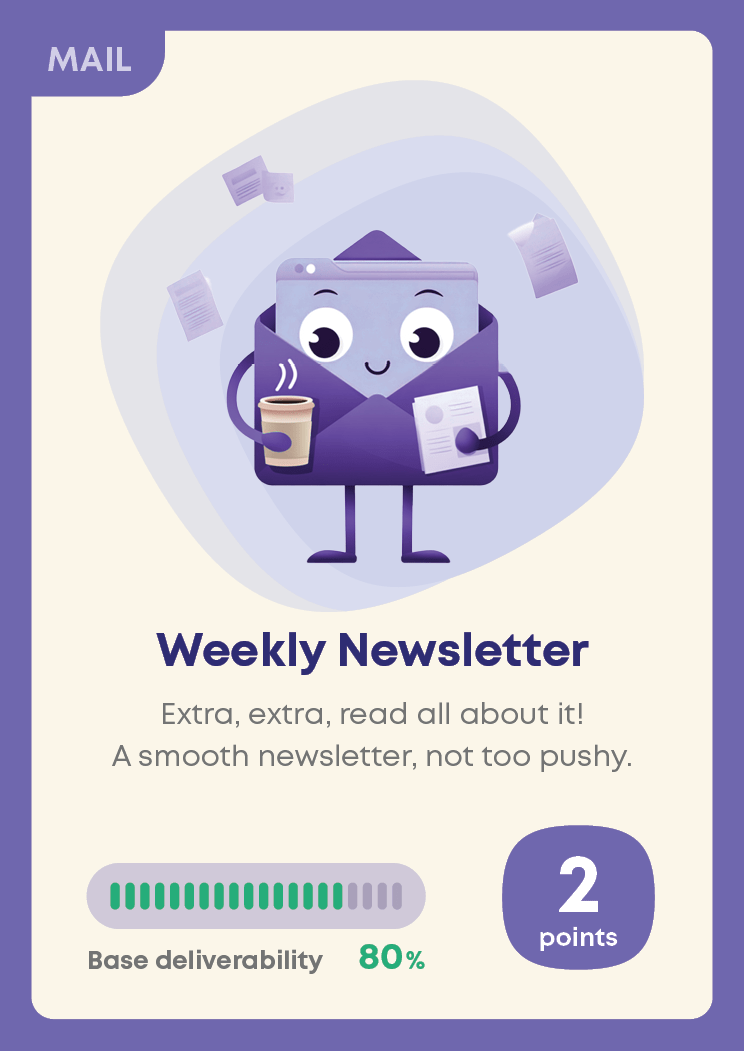
A steady newsletter builds familiarity and reputation over time.
But if open rates drop or content turns salesy, filters start shifting it toward Promotions or Spam.
Not ideal!
In play, this card teaches that quality and consistency beat volume.
Abandoned Cart Reminder

One of the riskiest but most profitable sends.
Abandoned cart emails have a clear commercial intent, so providers treat them cautiously.
Send too many too fast, and your IP looks aggressive.
The game’s lesson: smart segmentation and moderation protect your reputation while chasing conversions
Holiday Greetings

Harmless? Not really.
The inbox gets flooded with similar emails every holiday season.
Even good senders struggle to stand out or get delivered.
The takeaway here: send fewer, more personal greetings… not just mass “Happy Holidays” blasts.
New Product Launch
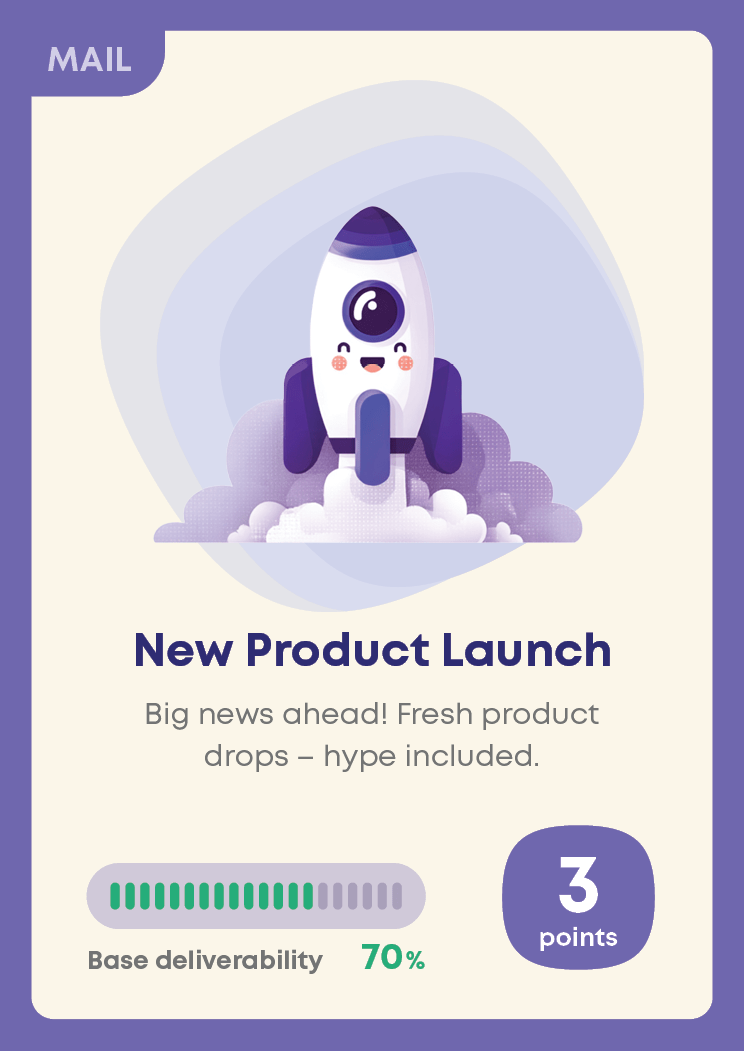
A big moment for marketers… and for filters.
Launch emails are often image-heavy and full of promotional language.
Without a strong sender reputation and authentication setup, they’re doomed to land in Promotions or worse.
The card captures the risk of hype without trust.
VIP Invitation

Urgency, exclusivity, links: all classic spam triggers.
But when sent to the right, engaged segment, they can work beautifully.
This card reminds you that personalization and targeting are your best armor against filters’ suspicion.
Black Friday Promo

The hardest battle in the inbox.
Volume spikes, extreme urgency, and spammy phrases… all at once.
Even trusted senders risk landing in junk during Black Friday week.
The lesson: warm up, authenticate, and test before launching any massive campaign.
Security Alert
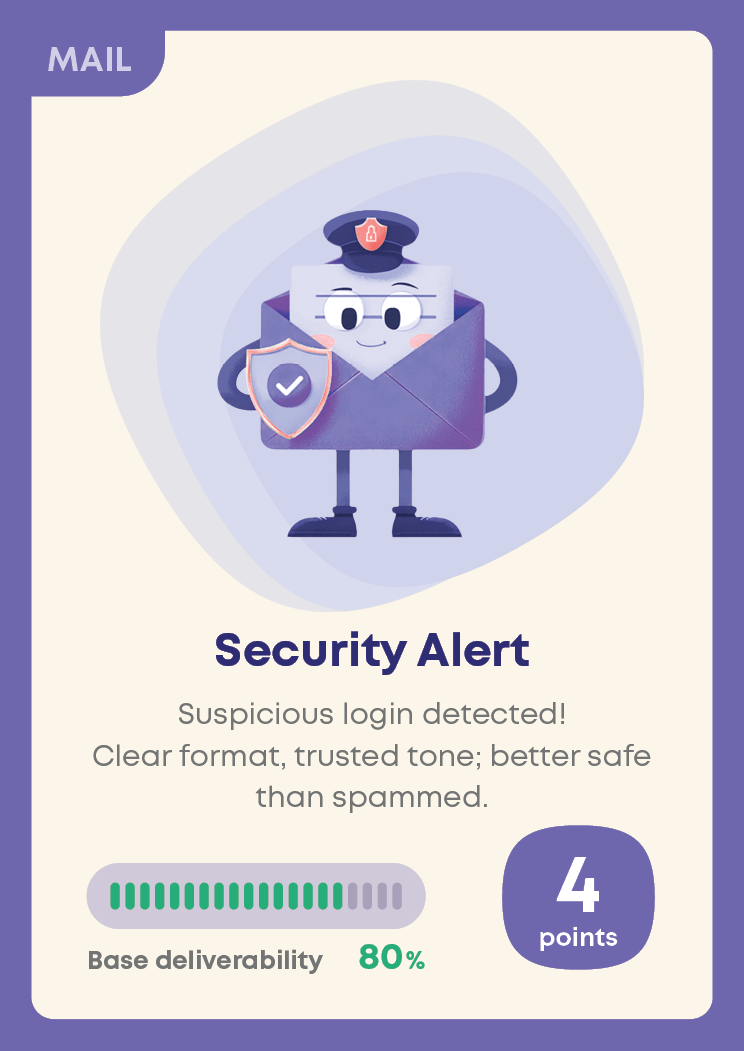
Critical messages like login warnings or account alerts are trusted by default… but only when formatted correctly.
Deviate from standard phrasing or add unnecessary visuals, and you’ll lose that trust fast.
In play, it’s a card about discipline and consistency.
Quarterly Report

Heavy attachments, long text, and images.
Corporate emails love them, filters don’t.
The key insight here: size and complexity affect inboxing as much as content.
Link to files instead of attaching them, and your deliverability climbs instantly.
Mega Campaign Blast

The boss level of email sending.
Giant volumes, flashy design, and sudden spikes: it’s everything filters fear.
Without warming up, throttling, or segmenting, such a campaign tanks your reputation.
Winning with this card means mastering balance under pressure.
Helpers
Smart subject line and preview

The first thing your recipient sees… and the first thing filters analyze.
A clever, honest subject line builds trust and engagement, signaling to mailbox providers that your emails are wanted. Clickbait, on the other hand, kills credibility fast.
In the real world, open rate is a huge trust factor; in the game, this card gives you a small but strategic bump to deliverability for knowing how to tease curiosity without lying.
SPF record

SPF (Sender Policy Framework) tells inboxes which servers are allowed to send on your behalf… like showing your passport at the airport gate.
Without it, filters assume you’re an impostor. It doesn’t guarantee inboxing, but it’s the foundation of email authentication.
Play it early; without SPF, your whole infrastructure looks shaky.
DKIM Signature
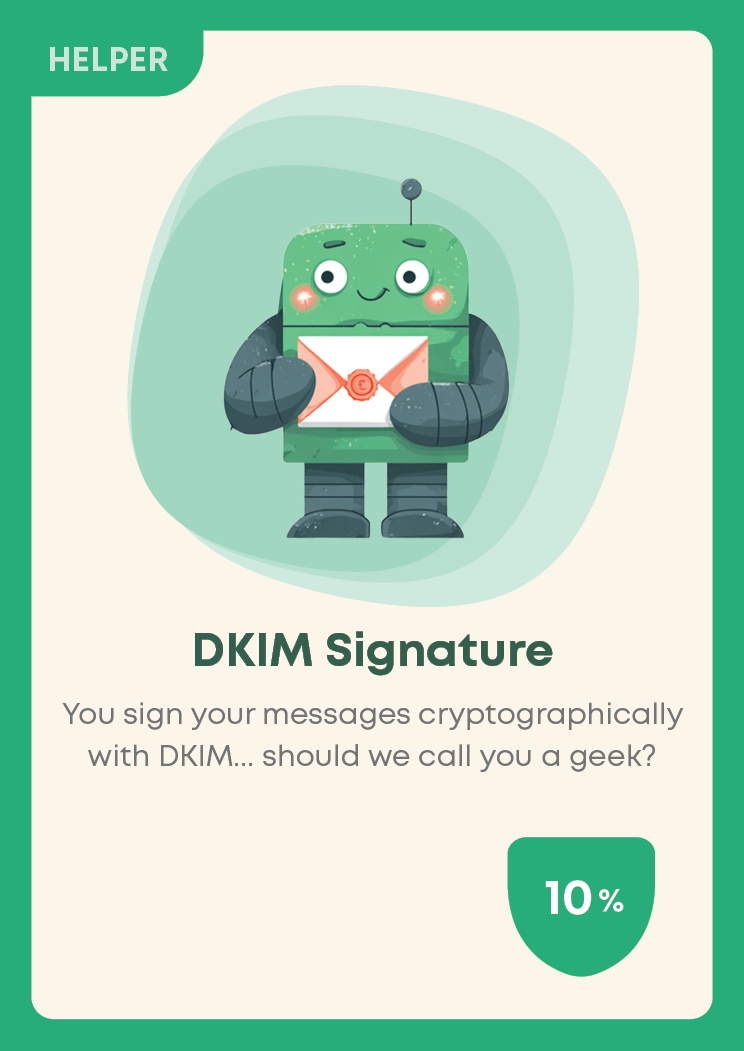
Think of DKIM (DomainKeys Identified Mail) as your personal wax seal.
It proves the message hasn’t been changed in transit and truly comes from you.
Missing DKIM is like sending an unsigned letter: it might still arrive, but nobody fully trusts it.
Add it, and filters breathe easier.
DMARC “None” Policy
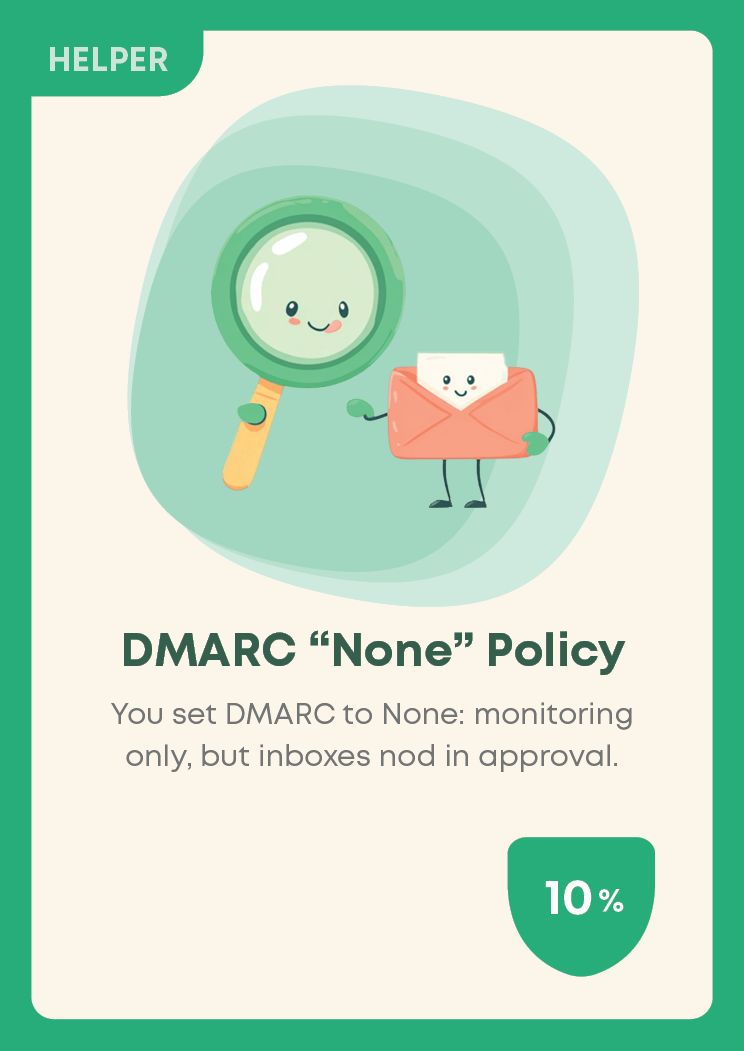
This is your training-wheel phase. You’re not blocking fakes yet, but you’re watching what’s happening.
Mailbox providers like that you’re paying attention to security, even if you’re not enforcing yet.
In real deliverability, “None” policies let senders collect data before going strict. In the game, it’s a smart setup move: quiet, but strategic.
DMARC “Reject” Policy

Full defense mode activated.
With a “Reject” policy, you tell inboxes to trash any spoofed emails claiming to be you.
That makes you look serious about protecting recipients. In deliverability, this is a huge trust signal: it says, “No frauds here.”
In the game, it’s one of the strongest shields you can play.
Clean message
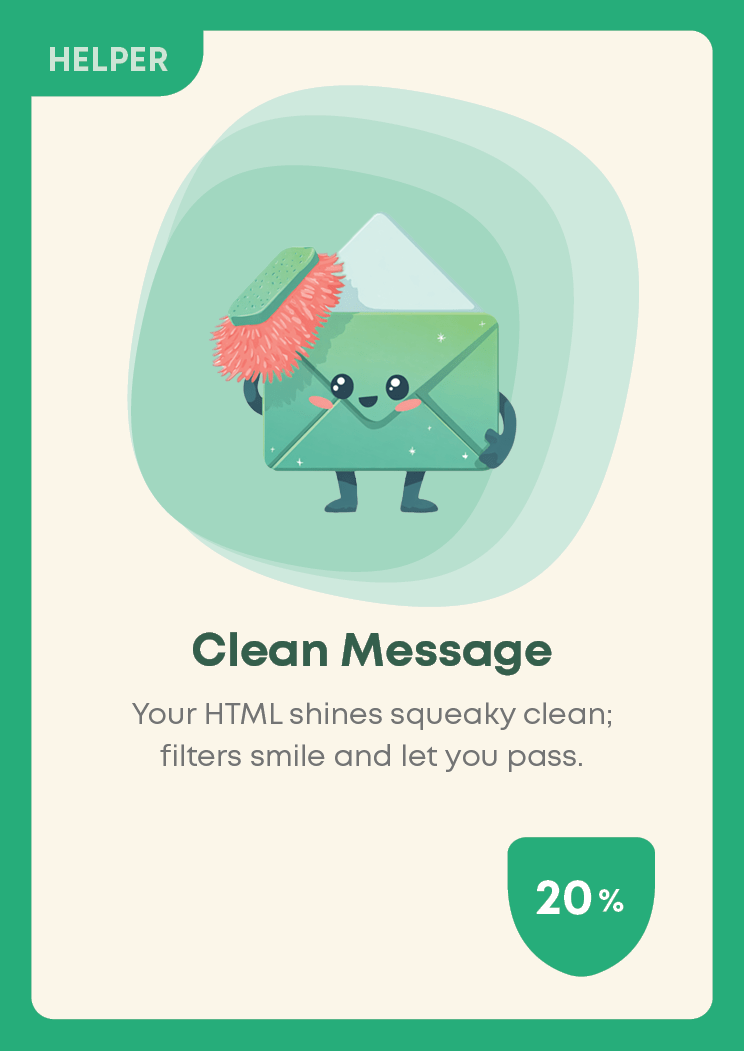
HTML full of broken tags or weird fonts makes spam filters twitch.
Clean, simple structure helps emails glide through.
Even minor errors like stray CSS or mismatched links can tank your inboxing.
Playing this card is like polishing your message before sending — light, tidy, and professional.
Monitoring the feedback
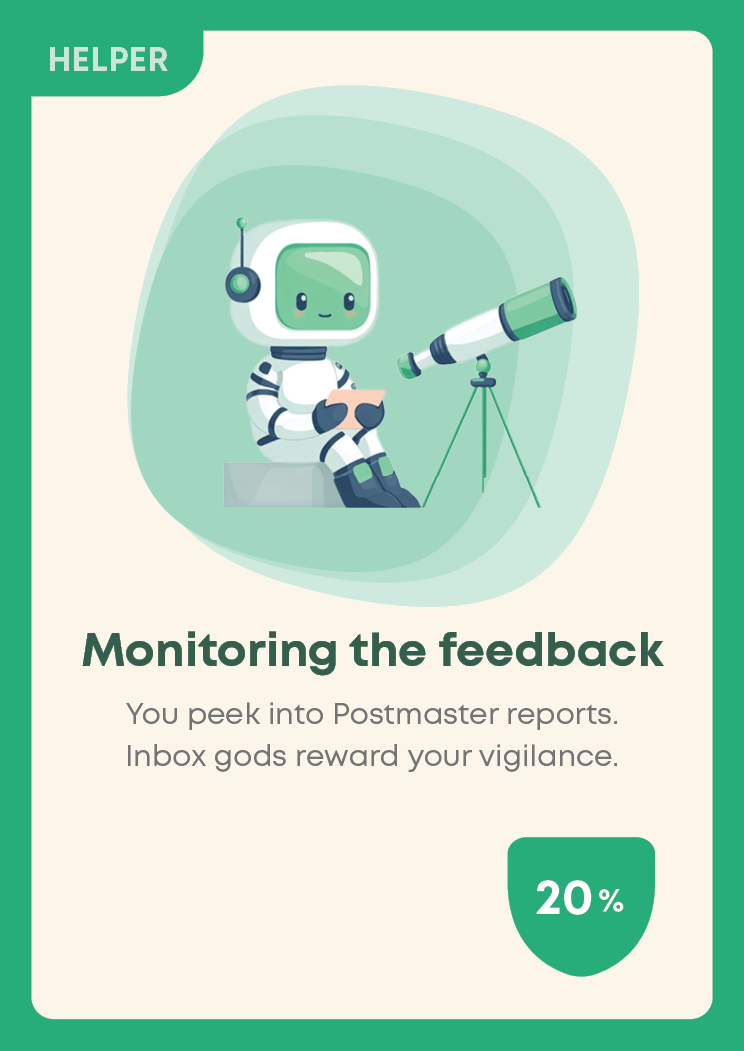
Postmaster tools (like Google Postmaster, Microsoft SNDS, or Postmark’s dashboards) show how inboxes really see you: from IP reputation to spam complaint rates.
Ignoring this feedback is like flying blind.
In the game, this card shows the power of awareness: fixing issues before they turn into blacklists.
Warm-up sequence
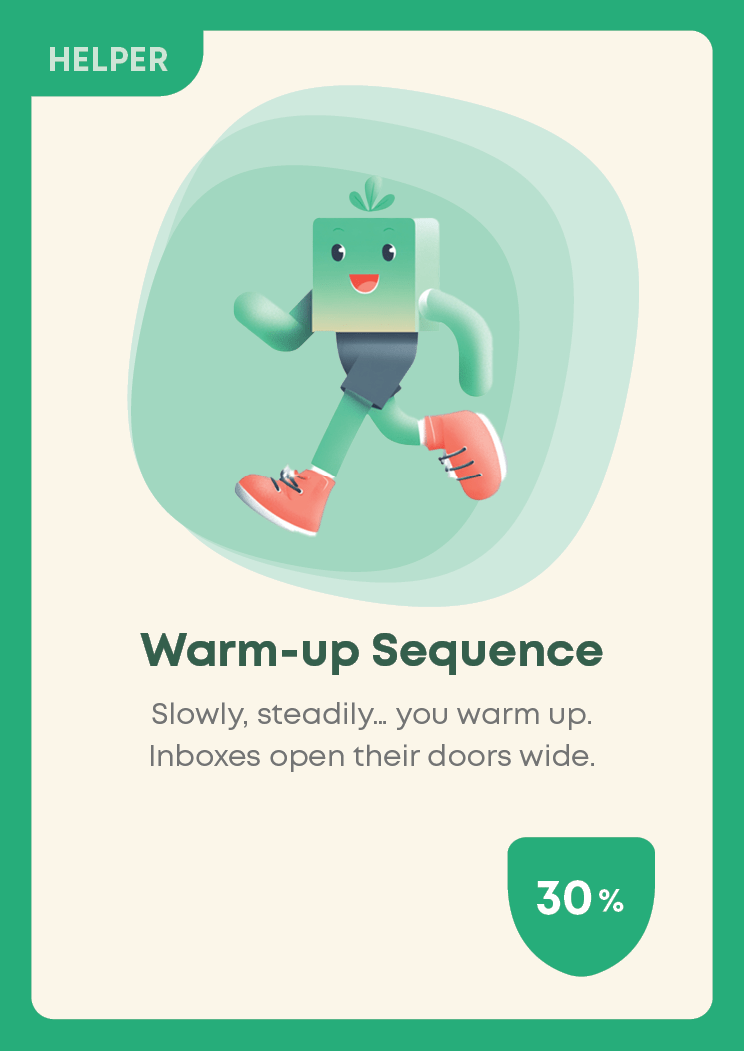
Sending big campaigns from a cold domain is like sprinting before stretching: you’ll get hurt.
Warm-ups tell inboxes, “Hey, I’m new, but I’m consistent.”
Gradually increasing your volume builds a steady reputation and earns deliverability trust.
Play this before a risky send; it’s your invisible armor.
Dedicated IP
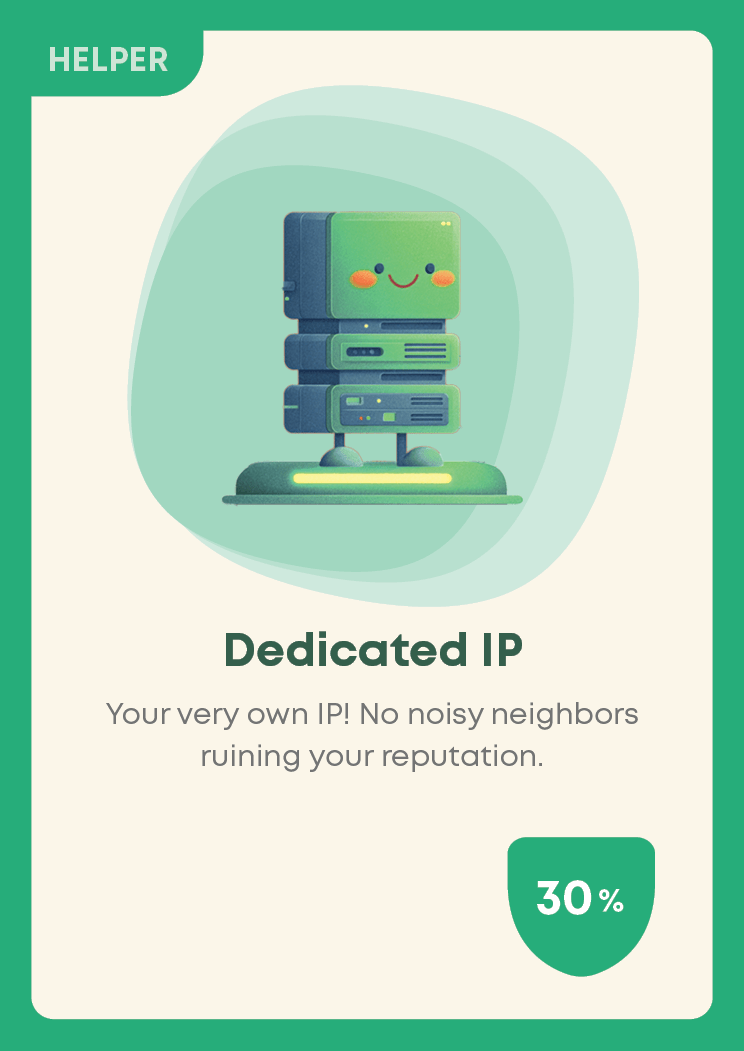
On shared IPs, your fate depends on strangers.
One bad sender, and you’re guilty by association.
A dedicated IP isolates your reputation, giving you full control over performance.
In real life, this card is expensive but powerful — and in the game, it’s how serious players separate from the crowd.
Deliverability tests
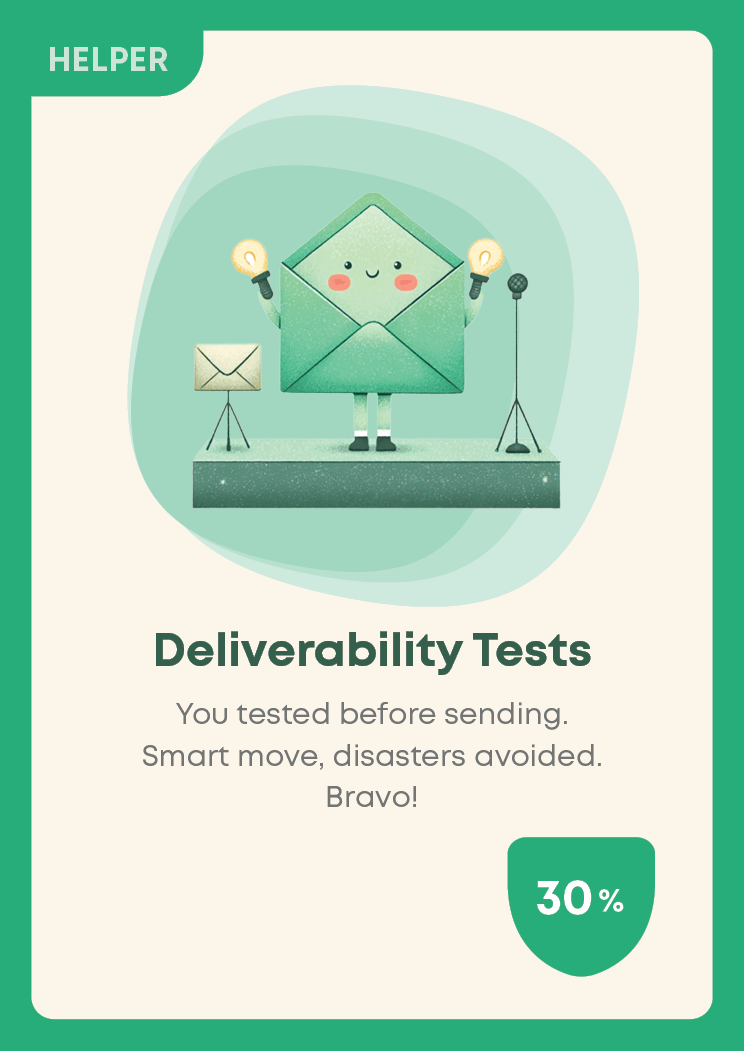
Seed testing means sending your email to sample inboxes across providers before the real send.
It’s like a rehearsal for your campaign.
You can see where it lands: Inbox, Promotions, Spam; and adjust before it’s too late.
In the game, this card saves you from catastrophic misplays.
List cleaned last quarter

Every inactive subscriber or bounce hurts your standing.
Cleaning your list every few months signals discipline and respect for users.
In reality, hygiene means fewer bounces, fewer spam traps, and better engagement.
In the game, this card gives stability — not flashy, but crucial.
Engaged and segmented audience
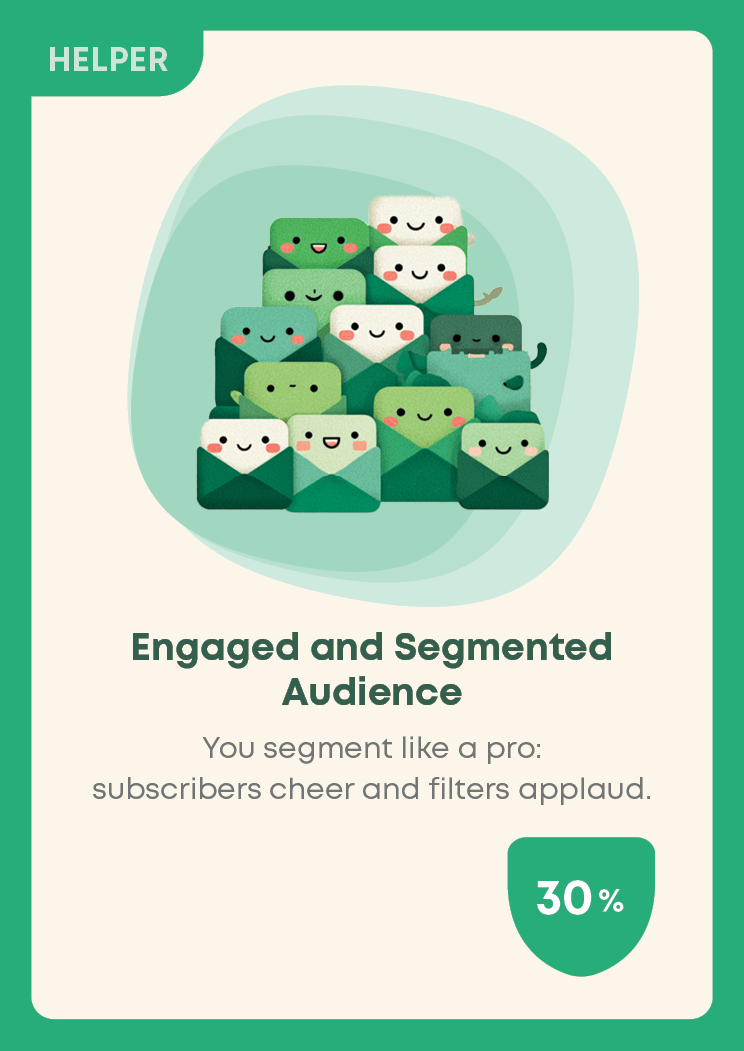
Filters don’t trust senders who blast everyone.
They trust those who know their audience.
Segmenting and sending to engaged users tells providers your mail is relevant: which boosts your inbox rate massively.
This card rewards strategy: quality > quantity.
Super-clean list (yesterday)
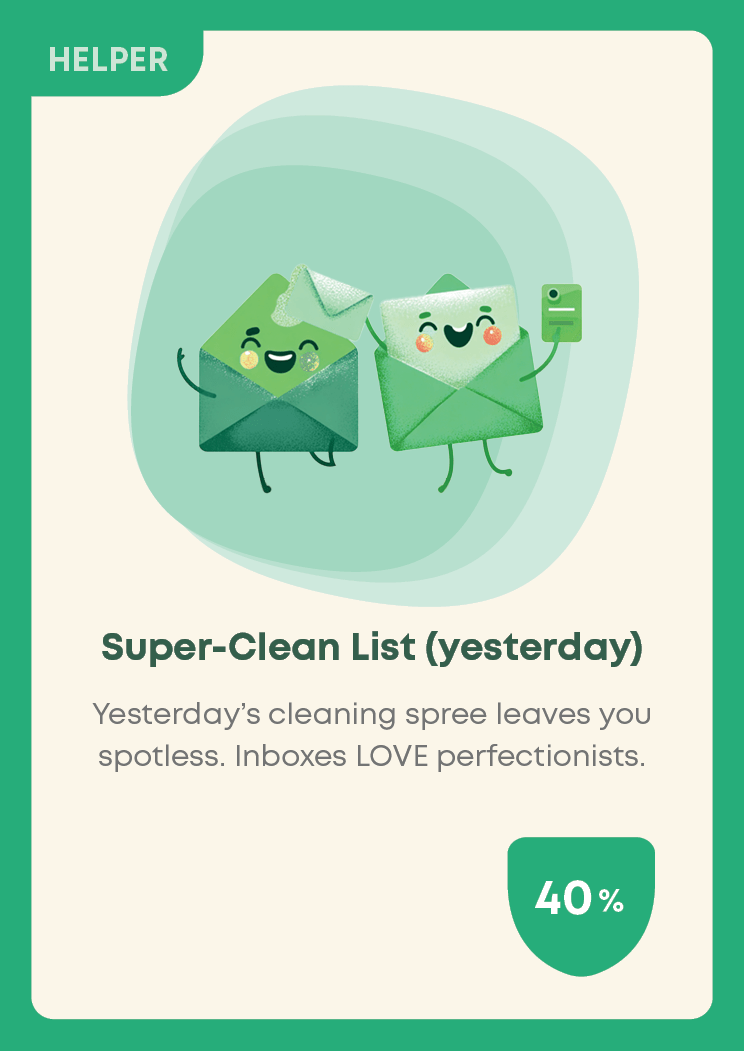
The ultimate hygiene play.
Cleaning your list right before sending guarantees minimal bounces and maximum inboxing.
Providers love it: it screams “responsible sender.”
In game logic, this is the equivalent of buffing your defense before the boss fight.
Deliverability expert on-board

Even pros make mistakes, but deliverability experts see what others miss: mismatched DNS records, slow warm-ups, bad engagement timing.
Hiring one in real life can save your sender score; in the game, it’s a major buff that protects you from hidden traps.
Raving fans
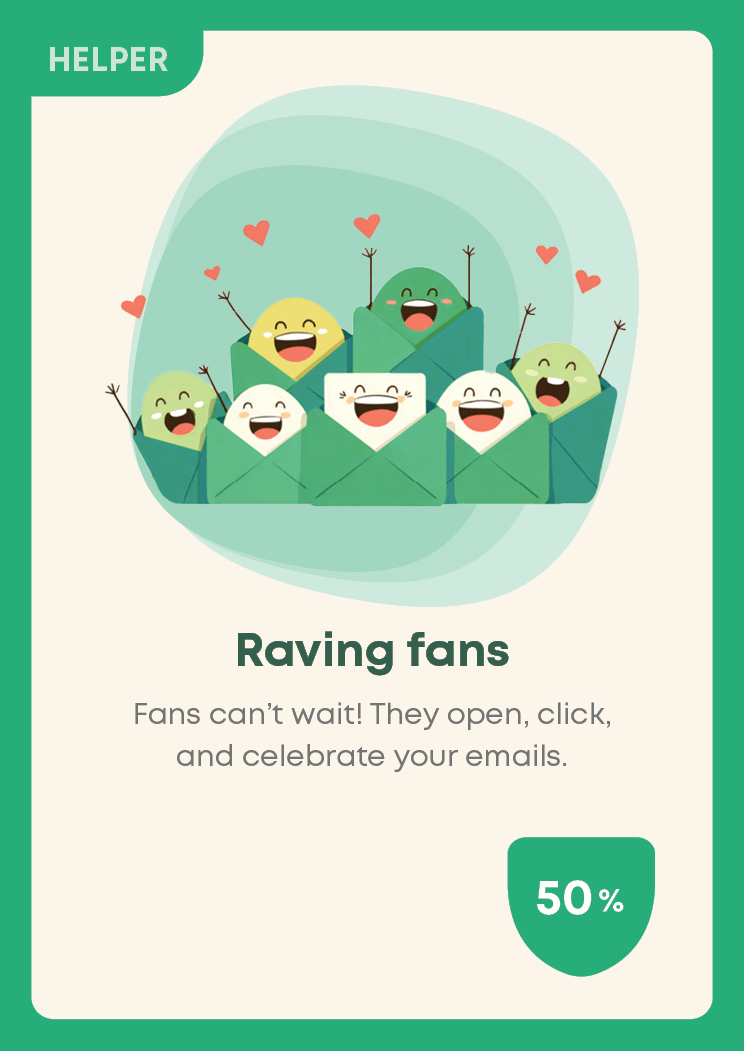
Engagement is the single biggest deliverability booster.
When people open, click, and reply to your emails, inboxes say: “This sender matters.” Loyal fans keep your reputation bulletproof.
In the game, this card is gold: hard to earn, but once you do, it’s almost unbeatable.
Strong reputation

The holy grail of deliverability.
You can’t buy it, fake it, or rush it.
Consistent, honest sending over time builds a “trusted sender” profile that protects you from minor mistakes.
In the game, this is your endgame buff: once you’ve earned it, even a few blockers can’t stop you.
Blockers
Low open rate

When people stop opening your emails, mailbox providers take notice.
They assume your content lacks value or relevance, and gradually lower your inbox priority.
Even high-quality campaigns start landing in Promotions or spam once engagement dips. In the game, this card punishes neglect: your audience’s silence becomes your worst enemy.
Too many links
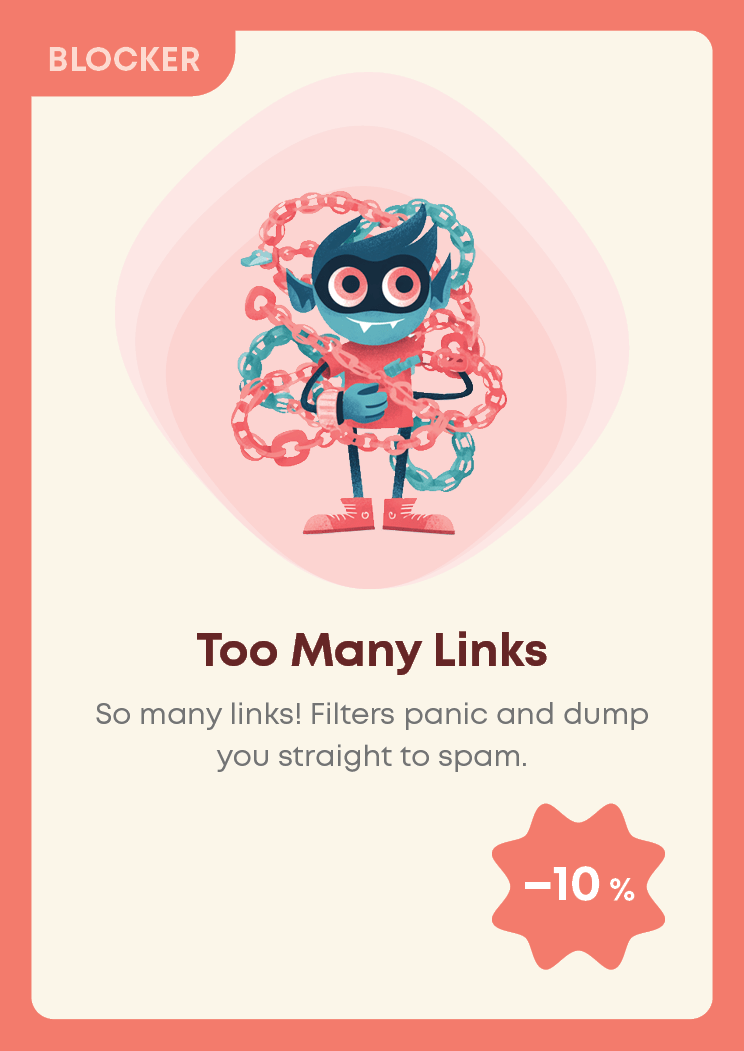
Every link is a potential risk signal.
Stuffing emails with CTAs, tracking URLs, and shortened links screams “promotion” to spam filters.
Even genuine senders can look shady if the message feels overloaded. In the real world, fewer, cleaner links mean trust. In the game, this card shows how overcomplicating design can break deliverability.
Copied from Word
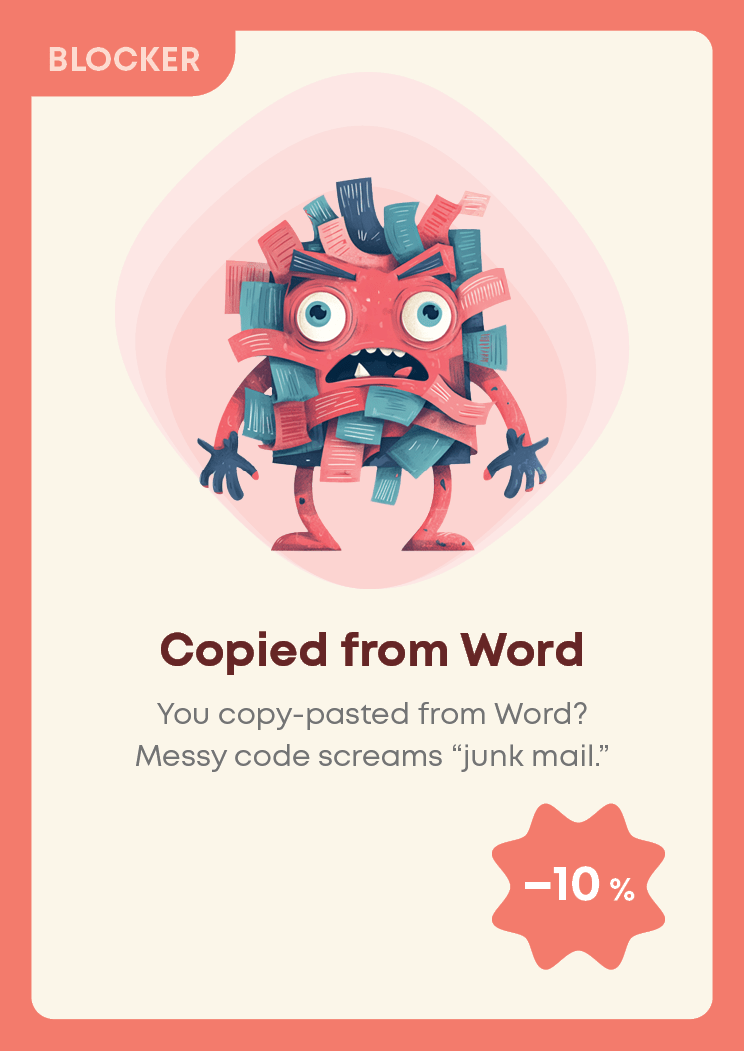
Copy-pasting from Word sneaks in hidden formatting, strange fonts, and broken tags that confuse filters.
Your message might look fine to you, but to a spam algorithm, it’s chaos.
Clean HTML or plain text fixes it.
This card reminds you that a sloppy sender often looks like a spammer.
Dirty HTML
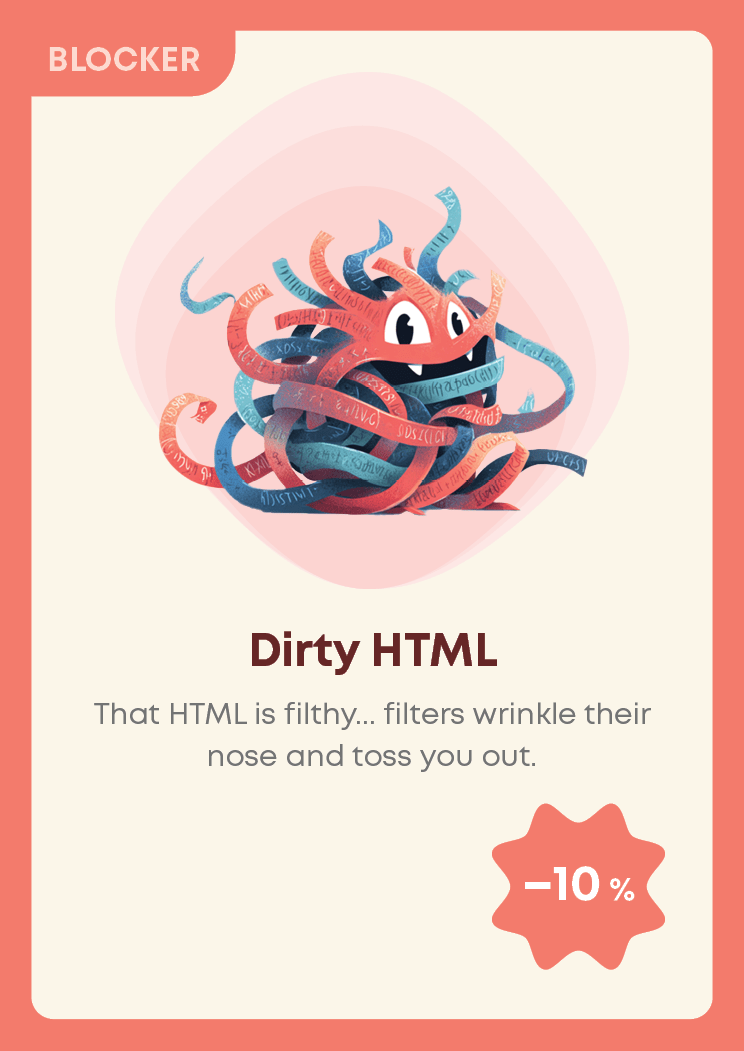
Behind every beautiful newsletter can hide ugly code.
Messy HTML (with broken tables, extra spaces, or inline styles) slows rendering and raises suspicion.
Filters interpret it as unprofessional or even malicious.
Playing this card represents technical debt: your design team didn’t validate before sending.
Broken links
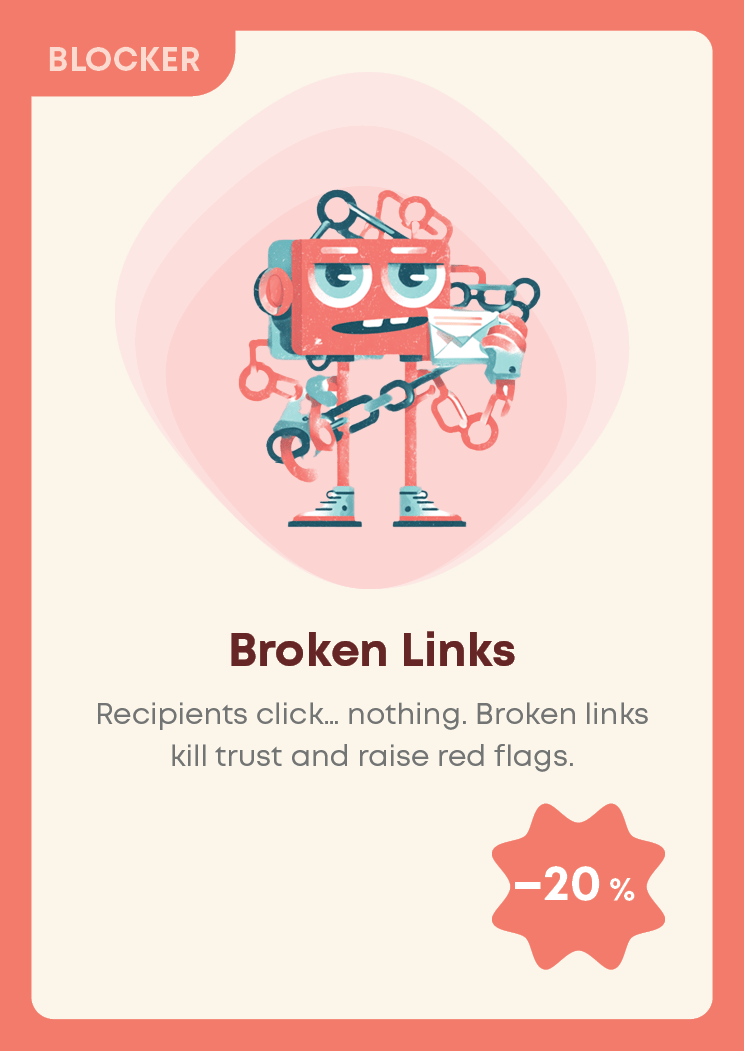
Clicking a dead link frustrates users and flags your domain as careless.
Providers track this behavior, downgrading your credibility fast.
Even a single broken redirect can drag an entire campaign down.
In the game, this is your “rookie mistake” card: one that even seasoned senders dread.
Content filter triggered

FREE!!! DISCOUNT!!! LIMITED TIME ONLY!!! –> words like these are magnets for spam filters.
Overly aggressive design or wording triggers security layers meant to protect users.
Balanced copywriting and natural tone are your real power-ups here.
In play, this card punishes hype over honesty.
One image
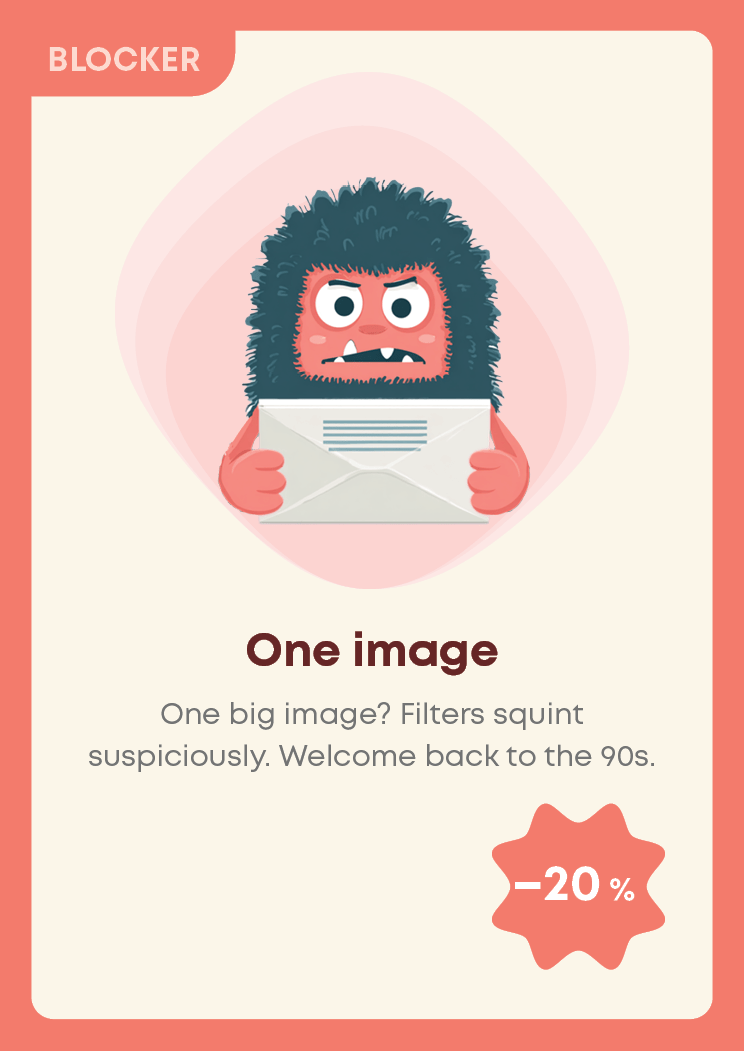
A single big image looks like classic spam.
Filters can’t read images, so they assume the worst.
Recipients may also block images by default :meaning your message might appear completely blank.
This card teaches why accessibility, text balance, and readability matter for inbox survival.
Inbox exhaustion
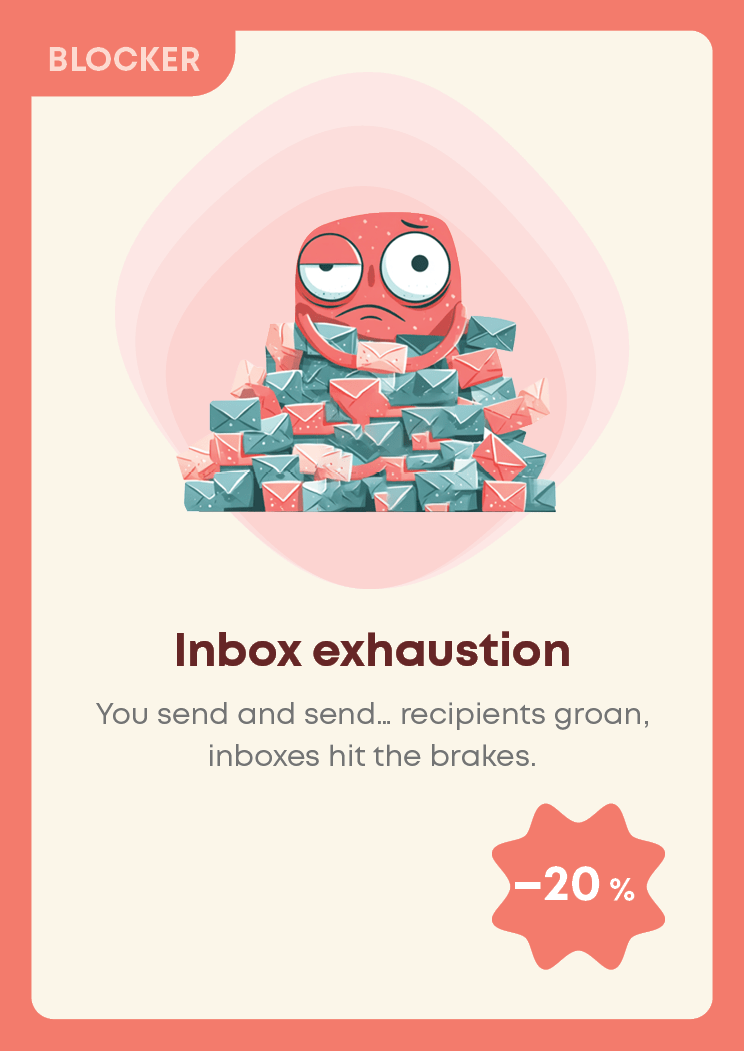
Too much of a good thing quickly turns bad.
Sending too often floods users and irritates filters.
Engagement drops, unsubscribe rates climb, and soon your domain looks like a spam cannon.
In the game, it’s the burnout card: consistency beats intensity.
Misleading subject line
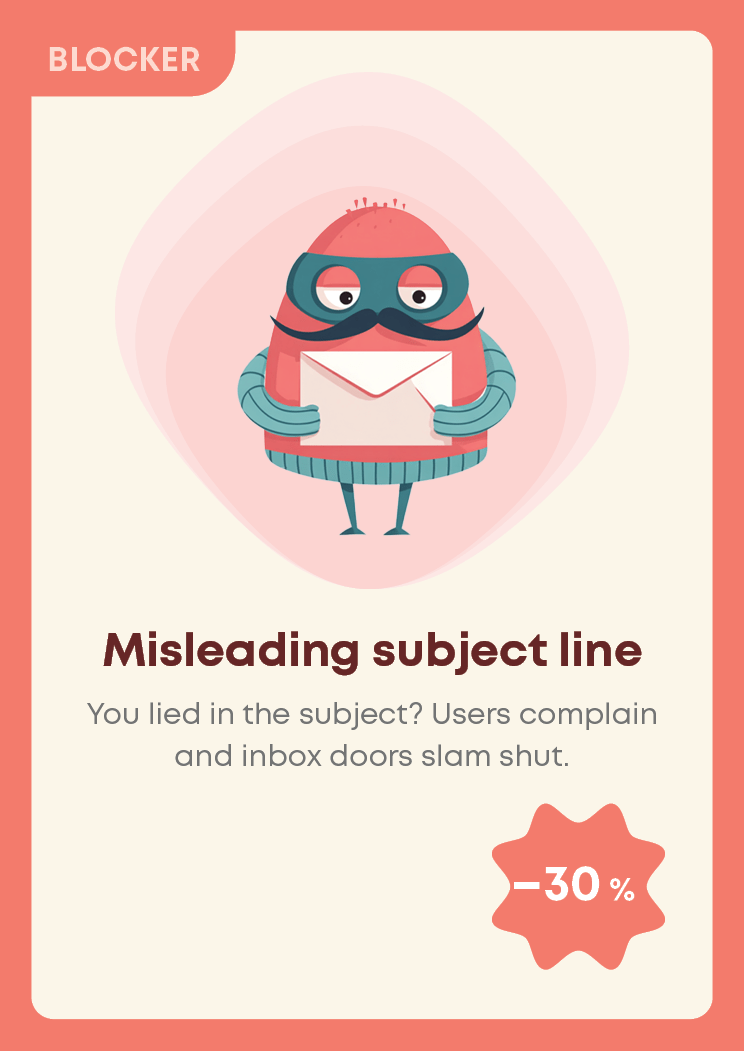
“Exclusive deal!” followed by… a survey.
Bait-and-switch tactics get you reported fast. Mailbox providers monitor user behavior, and every complaint chips away at trust.
Even one dishonest subject line can cause months of damage.
This card symbolizes short-term wins that wreck long-term reputation.
No segmentation

Sending the same message to everyone means ignoring context and interest.
Engagement plummets, and filters see that as irrelevance: the worst signal of all.
In deliverability, segmentation equals respect.
In the game, this card punishes lazy marketing.
Spam complaint
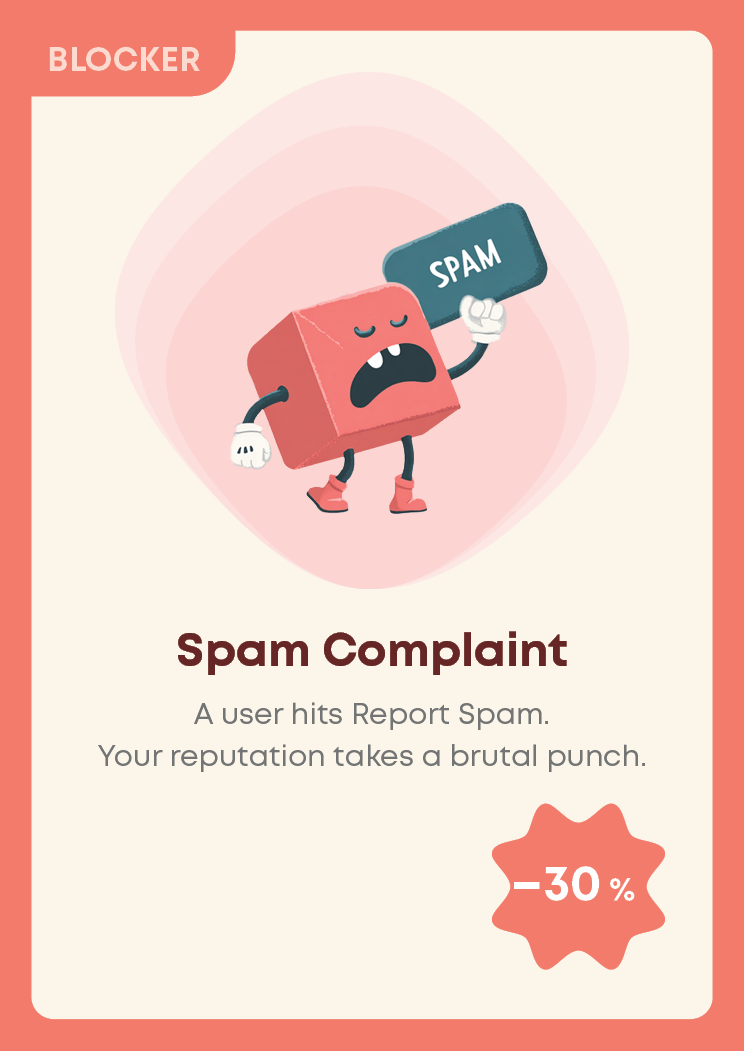
Few things hurt faster than a “Report Spam” click.
Providers treat it as a direct vote against your credibility.
Too many, and you’ll face throttling or outright blocking.
In the game, this card is brutal: it damages everything else you’ve built.
High bounce rate
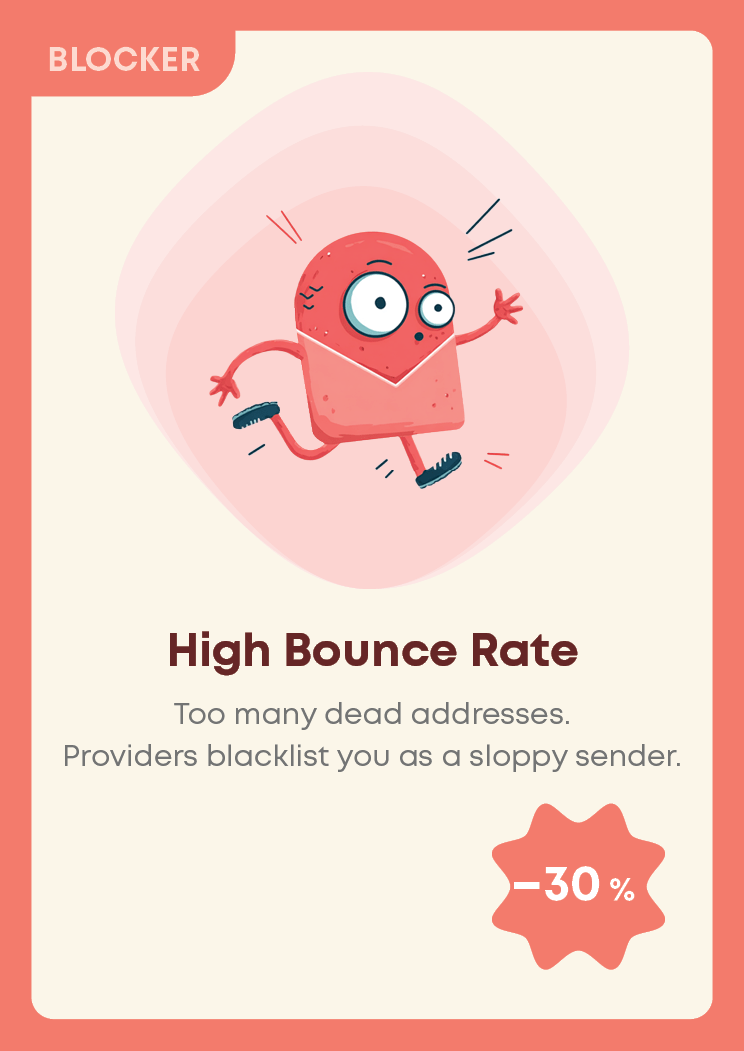
Invalid or inactive addresses don’t just waste credits: they destroy reputation.
Each bounce tells providers your list is outdated or scraped.
Even good emails get caught in the fallout.
In play, this is the punishment for skipping list hygiene.
Spam trap
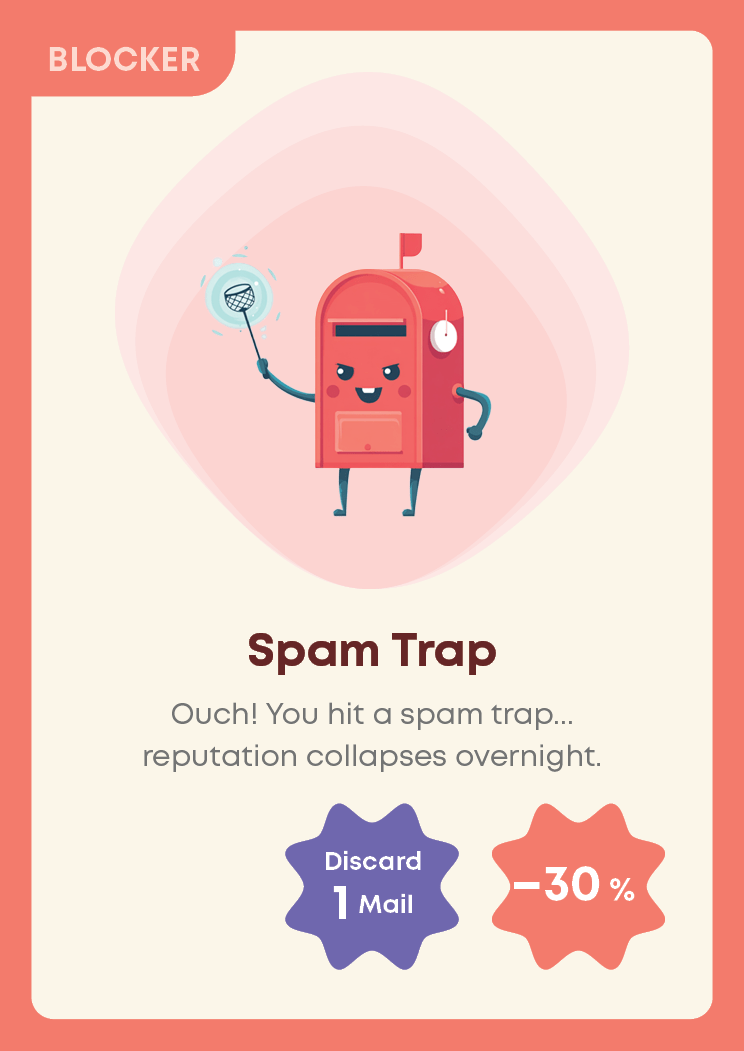
Spam traps are hidden addresses used by providers to catch careless senders.
If you hit one, it’s a signal that you’re buying lists or not cleaning properly.
The penalty is steep: instant loss of trust and deliverability collapse.
In the game, it’s a deadly mistake: a single bad address can ruin your round.
Out of the blue
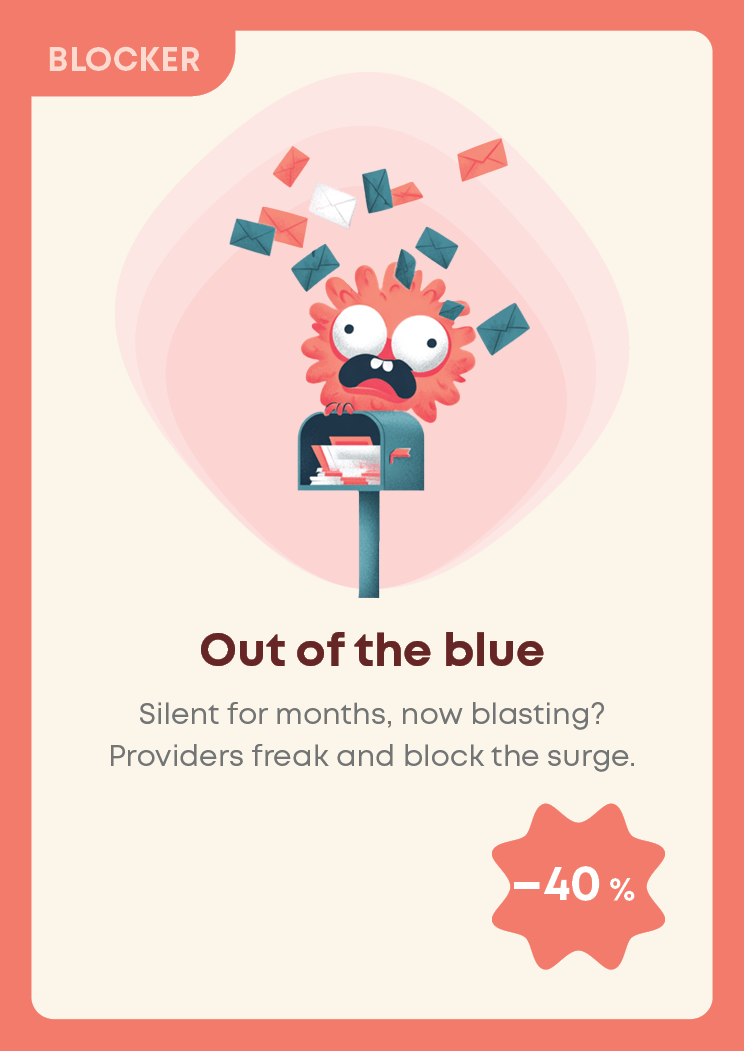
You went silent for months, then suddenly blasted 100k emails?
Filters panic.
Sudden spikes look like compromised accounts or botnets.
The real-world cure is gradual scaling, testing, and patience.
In the game, this card punishes neglect: you can’t build trust overnight.
Blacklist entry

The nightmare scenario.
Blacklists are public “do not trust” lists that providers use to block malicious senders.
Once you’re on one, recovery takes weeks or months.
In the game, it’s your fall from grace: one that demands effort, not luck, to undo.
Phishing flag
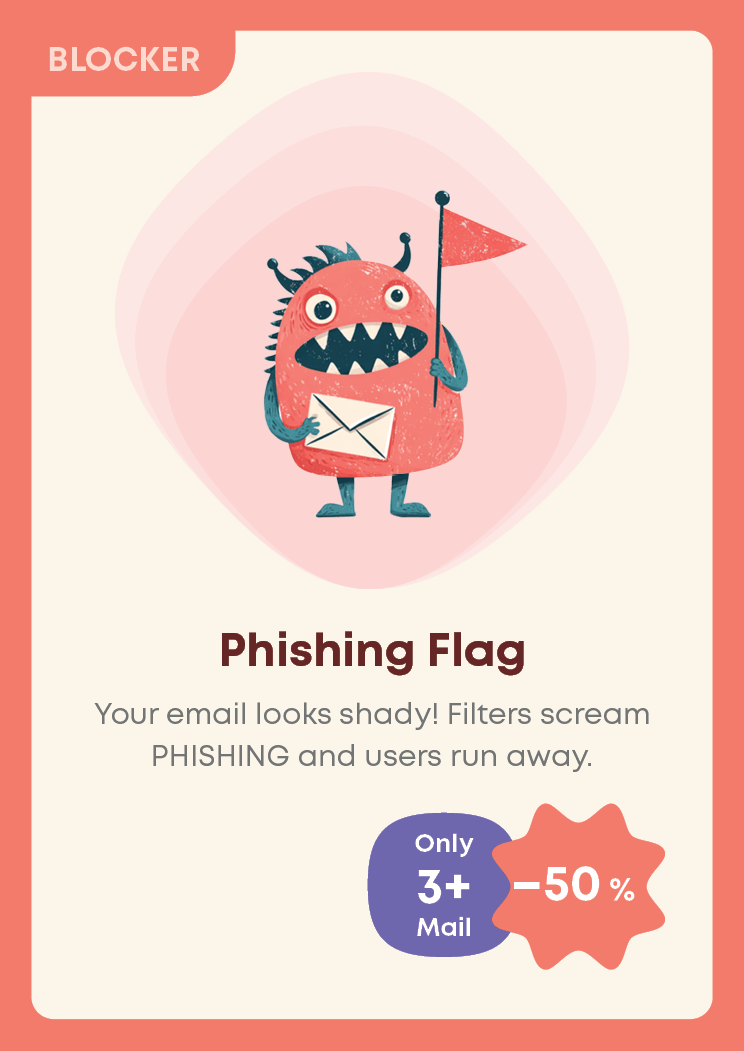
If your email looks like phishing: fake login pages, mismatched domains, shady buttons… filters don’t hesitate.
Even legitimate messages can get caught in the crossfire.
Once flagged, future campaigns suffer too.
In play, it’s your most dangerous card: powerful against high-value sends, but devastating if it hits you first.
